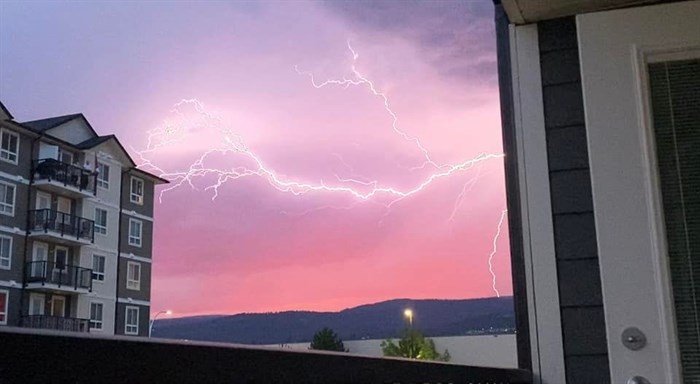
Lightning and a sunset in Kelowna, Aug. 11, 2022.
Image Credit: SUBMITTED/Regan La Rose-Smith
September 02, 2022 - 7:00 AM
August 2022 was the hottest on record for the Okanagan and (essentially) Kamloops, as it was for much of B.C.
Plus, the province as a whole had the fourth highest number of lightning strikes of any August over the last 20 years.
Yet there has only been an average number of wildfires in B.C. this summer and the land burned has been only about one-tenth of normal.
Put that strange but successful combination down to one key factor this year – a typically damp June.
“June is the monsoon month of summer,” Environment Canada meteorologist Doug Lundquist told iNFOnews.ca. “We had that wet and humid June. Notwithstanding that it’s been extraordinarily hot since the 15th of July, we had the perfect summer for fire weather but June did what it was supposed to.”
READ MORE: Doug Lundquist does more than predict the weather – he helps save lives
What June is "supposed" to do is get enough moisture soaking into the ground to keep it from drying up too quickly when the heat of summer hits.
While Kamloops only had about 28 millimetres of rain in June, there were 55-90 mm recorded in Okanagan cities.
By mid-July, the high pressure and heat rolled in with a series of heat domes that gave the Okanagan the hottest August on record while it was the second hottest August in Kamloops only because its records go back further.
READ MORE: This was the hottest August ever for the Okanagan but Kamloops fell short
There were more than 126,000 lighting strikes in B.C. by Aug. 30, making it the fourth highest on record. That peak was in 2013 when 231,000 lightning strikes were recorded, Lundquist said.
The province gets an average of 73,000 lightning strikes each year.
Environment Canada did not have a breakdown of lightning strikes per city for this year but B.C. Wildfire Service said there were 15,220 in the Kamloops Forest District in August.
On the other hand, Environment Canada does post online how many lightning strikes there were between 1999 and 2018 within 25 km of 28 B.C. cities, along with others across Canada.
The average for Kelowna was 6,624 strikes per year, 7,642 in Kamloops, 7,652 in Penticton and 7,253 in Vernon.
That does not put the Thompson-Okanagan region anywhere near the list of lightning hot spots in Canada, or even B.C.
Of the 28 B.C. cities on the list, Dawson Creek got the most lightning at 16,383 while Prince Rupert averaged only 152.
“The Interior of British Columbia, despite having a long lightning season, has relatively low lightning density,” the Environment Canada website says. “East of the Rocky Mountain continental divide, a pronounced area of higher lightning activity occurs over the Rocky Mountain Foothills and the Swan Hills of Alberta. Southern Saskatchewan and southern Manitoba have an area of relatively high lightning activity.”
Of 15 Alberta communities on the list, Edson ranked the highest at 45,124. That was topped by Saskatchewan’s most lightning-prone city, Estevan, with an average of 54,025.
“Southwestern Ontario sees some of the highest lightning flash densities in the country,” Environment Canada says. “This region is located in a lake-breeze convergence zone, where a lake air mass meets a land air mass, between Lakes Huron and Erie.”
That leaves Windsor, ON as the lightning capital of Canada with an average of 109,776 strikes per year.
On the wildfire front, B.C. has recorded 1,356 fires to date, not far off the 10-year average of 1,352.
But, there have only been 43,116 hectares burned so far this year, well below the 348,917 ha average for the past 10 years.
Last year, there were 1,622 wildfires but they burned 869,279 ha, with 497,497 ha being in the Kamloops Fire District.
To contact a reporter for this story, email Rob Munro or call 250-808-0143 or email the editor. You can also submit photos, videos or news tips to the newsroom and be entered to win a monthly prize draw.
We welcome your comments and opinions on our stories but play nice. We won't censor or delete comments unless they contain off-topic statements or links, unnecessary vulgarity, false facts, spam or obviously fake profiles. If you have any concerns about what you see in comments, email the editor in the link above.
News from © iNFOnews, 2022